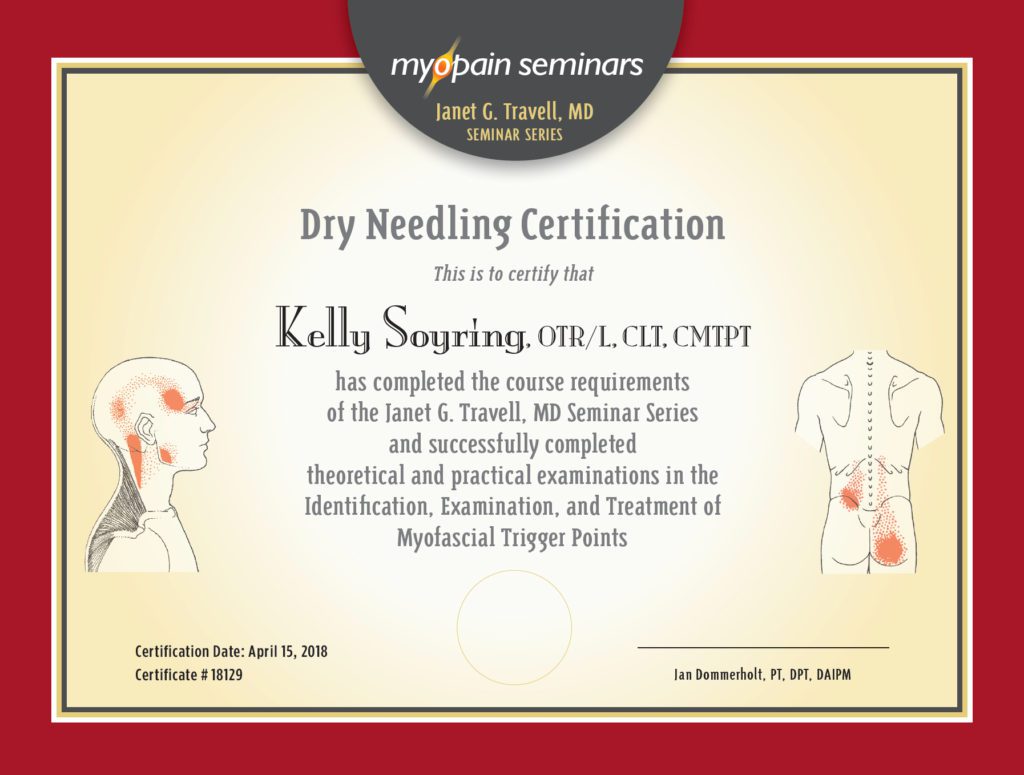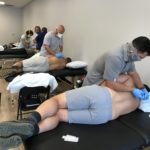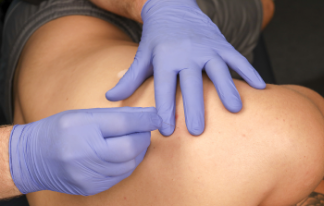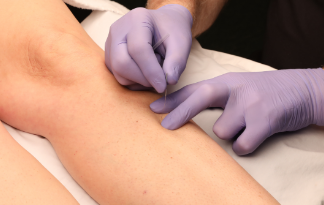Finding an Effective Treatment in Dry Needling as an OT
When you hear patients say things like, “I didn’t know I didn’t have to live with that pain,” “I have never felt better,” and “I feel like I have my life back,” you know you are offering treatments that work. I chose to become an occupational therapist (OT), so I could help people. Yet, when I first began to practice in an outpatient clinic, I was not getting the outcomes I wanted. I would often feel frustrated that the traditional modalities were not working. It wasn’t until I completed dry needling training with Myopain Seminars that I began to feel confident I could help patients, even difficult chronic pain patients. After adding dry needling to my treatment plans, I see improved patient outcomes, and I am more successful with treating patients with persistent pain. I now have more effective modalities, and my patients can see results on the first visit.
After introducing dry needling to my Northern Minnesota community, I became inundated with new patients as news of the successes with dry needling spread quickly. I continue to struggle to keep up with referrals as it is evident to the community that dry needling greatly benefits many patients. They often refer their family members and friends, keeping me busy and saving me advertising costs. Adding dry needling as a treatment modality has changed how I practice, allowing me to help my patients in ways I have only dreamed of.
My Dry Needling Certification: An Occupational Therapist’s Perspective
 This blog aims to share the benefits of dry needling as an occupational therapy treatment modality, review dry needling regulations and research for occupational therapy, and share how the national and state legislative boards define regulations.
This blog aims to share the benefits of dry needling as an occupational therapy treatment modality, review dry needling regulations and research for occupational therapy, and share how the national and state legislative boards define regulations.
But first, I want to take a minute to share how I personally benefited from a dry needling education at Myopain. I took my first Myopain Seminars dry needling course in 2017, and I was astounded by the healing I experienced and witnessed. During the courses, therapists and instructors are demonstrating and practicing the dry needling techniques on each other. While practicing dry needling techniques, students taking the courses frequently get dry needled for existing pain and dysfunction. I was dealing with headaches and shoulder pain at that time, and after treatment in that course, I had a complete resolution of symptoms of shoulder pain and a dramatic decrease in my daily headaches. Because I experienced such considerable changes in my own pain, I was motivated to learn more about it and share dry needling with my patients. I continue to see consistent and immediate changes among patients from dry needling treatments.
Why Aren’t There More Occupational Therapists Doing Dry Needling?
There are far fewer occupational therapists offering dry needling than physical therapists; however, dry needling is picking up momentum among occupational therapists. Occupational therapists really can make a difference using dry needling. Course programs are starting to market-specific training for occupational therapy. For example, Myopain Seminars is now offering Occupational Therapy Dry Needling Certification courses. At this time, the guidance for occupational therapists using DN is limited. As more occupational therapists witness the benefits of dry needling, we look to our boards for more guidance. Each state has a unique practice act that defines the scope of practice for occupational therapists in that state. This can make it difficult to determine your state’s opinion on dry needling. Some states have not produced a statement on dry needling, some are for it, and some states say that dry needling is not allowed. It may take some research, and you may have to reach out to your state board for further information about your state’s practice act. Since most written rules about dry needling are defined for and by physical therapists, we must also consider physical therapy state acts for guidance on the legality of dry needling.
So as an occupational therapist, it is essential to review and follow both the physical therapy and occupational therapy state practice acts to determine your state requirements and regulations on dry needling. The lack of specificity and differences among states can make dry needling regulations challenging to navigate.
The Occupational Therapy Dry Needling Task Force
The American Occupational Therapy Association (AOTA) dry needling task force met to identify and define how dry needling fits into the occupational therapy scope of practice. At the May 2021 Representative Assembly (RA) meeting, the task force presented its early findings and strongly supported dry needling within the OT scope of practice. However, as I mentioned earlier, they also identified limitations in the 2017 research articles used to support the 2017 statement, making that statement invalid. The task force also confirmed current limitations in the number of studies, methodology, and use of outcome measurements. However, they did identify evidence that dry needling has a positive impact on occupational performance. Therefore, it appears that, at a minimum, the COP will retract the 2017 statement on dry needling, if not update it in support of dry needling. We can only hope that positive changes will be forthcoming. AOTA members can read the Report of the AOTA Representative Assembly Dry Needling Task Force.
Scientific Review and Evidence of Improved Occupational Performance
A recent high-quality systemic review, published in the American Journal of Occupational Therapy, concluded that dry needling might positively impact occupational performance compared with other interventions in treating individuals with spasticity. Byrum and colleagues (2021) concluded that dry needling is an effective physical agent modality to decrease spasticity and increase range of motion. Ten articles were identified, which were grouped by outcome measures. Changes in function were assessed with the Modified Ashworth Scale. Of the ten studies, four demonstrated a significant decrease in spasticity, and seven showed a significant increase in range of motion after dry needling. Of the five studies evaluating spasticity, only one study did not show a significant improvement. Although the decrease in spasticity was not statistically significant, participants did experience a statistically significant improvement in range of motion. Of the nine articles that addressed range of motion, two did not show significant improvement. This is one of the systemic reviews the task force cited in support of occupational therapists and dry needling in its presentation to the AOTA. Once the AOTA supports dry needling within the occupational therapy scope of practice, more occupational therapists could conduct research and use dry needling in clinical practice. In addition, state legislators would be more likely to update the practice acts to include dry needling.
National & State Guidelines on Dry Needling for Occupational Therapists
The American Society of Hand Therapists (ASHT) does not have a formal position on dry needling at this time. According to the ASHT, “the current body of evidence neither supports nor refutes the use of dry needling in the practice management of the hand and upper extremity.”
As occupational therapists, we look to the AOTA to guide the scope of occupational therapy practice and dry needling. The AOTA currently has not published an official statement on dry needling. They are in the process of revisiting their previous findings of dry needling issued in 2017, which stated:
Currently, limited available evidence exists in the occupational therapy literature investigating the use of dry needling. Available literature in other healthcare professions has reported mixed outcomes in general and as related to function (2017).
This statement from the AOTA on dry needling and the lack of support by the AOTA’s Commission on Practice (COP) may explain why many states are indifferent to using dry needling or don’t support dry needling. The ASHT confirms that “each state is independent to determine its own laws and rules, board opinions, and actions, which have varied widely around dry needling. This has created inconsistent requirements for physical and occupational therapists seeking guidance to use dry needling within their scope of practice. To date, there are no known national credentialing standards to govern the competencies of those teaching and those taking dry needling courses.” This may also explain why there is a lack of research on dry needling within the practice of occupational therapy.
The Future of AOTA’s Stance on Dry Needling
If the AOTA does not officially consider dry needling to be a part of the occupational therapy scope of practice, research will be challenging to obtain and reference. The majority of state practice acts follow what is happening at the national level. States may have some apprehension about adding a statement to the practice act about dry needling without formal support from the AOTA. However, there is some reason for optimism: in 2020, the AOTA created an occupational therapy dry needling task force. The task force presented its findings to the AOTA, and change has been set in motion. Most importantly, the task force invalidated AOTA’s 2017 statement.
Dry Needling Regulations By State & Requirements
State laws or regulations allowing occupational therapists to use dry needling are not as easy to find. In some states, the occupational therapy profession appears to follow the provisions in place for physical therapists, such as in Wisconsin. In a few other states, there are OT-specific rules in place.
- In Alabama, dry needling is within the scope of occupational therapy as long as the clinician has received appropriate training or education to render such service.
- On June 13, 2022, the Alaska State Physical Therapy and Occupational Therapy Board informed Myopain Seminars that “we are a licensing board and do not answer scope of practice questions. Please check in with the Alaska Physical Therapy Association to confirm their policies on this matter.”
- On June 13, 2022, the Occupational Therapy Examining Committee of the Arkansas State Medical Board, Arkansas Department of Health shared with Myopain Seminars that “the Occupational Therapy Examining Committee previously voted that a statutory change to the Occupational Therapy Practice Act would need to be made to include dry needling in the occupational therapy scope of practice. However, the Committee will be addressing this topic at the June 20, 2022 meeting. Additional information may be available following that meeting.” Unfortunately, that meeting was canceled. Instead, the Committee met on July 11, 2022, and discussed dry needling. The vote was to continue to research the procedure.
- In California, dry needling is not within the scope of occupational therapy.
- When Myopain Seminars approached the Georgia State Board of Occupational Therapy (June 2022), we were informed that the Board “may not provide what is considered legal advice regarding scope of practice to any third party due to any potential and unforeseen legal ramifications for providing such advice.”
- The Maryland Board of Occupational Therapy intends to develop regulations specific to dry needling in the near future. There will be an opportunity for public comment when the laws are proposed. Please be aware that at least one course provider erroneously states that dry needling is within the scope of OT practice in Maryland.
- The New Hampshire Occupational Therapy Governing Board used to have a statement on its website supporting dry needling by OTs, but following a recent revision of the site, that statement was no longer available.
- In Ohio, the Occupational Therapy Section on dry needling concluded that:
In accordance with section 4755.04 (A)(3) of the Ohio Revised Code, it is the position of the Occupational Therapy Section that occupational therapy practitioners may use physical agent modalities, such as dry needling in the provision of occupational therapy services provided that the occupational therapy practitioner demonstrates and documents competency in the modality, in accordance with rule 4755-7-08 of the Administrative Code, and is practicing within the occupational therapy scope of practice.
- Occupational therapists in Tennessee are allowed to use dry needling of the upper limb, with proper training and certification. According to the Texas Board of Occupational Therapy Examiners:
- According to §362.1(29)(C)(xiii) of the OT Rules, occupational therapy interventions and procedures that promote or enhance safety and performance in activities of daily living (ADL), instrumental activities of daily living (IADL), education, work, play, leisure, and social participation include the application of physical agent modalities, and use of a range of specific therapeutic procedures (such as wound care management; techniques to enhance sensory, perceptual, and cognitive processing; manual therapy techniques) to enhance performance skills.
- The Texas Board of Occupational Therapy Examiners does not dictate the specific modalities, techniques, or procedures that may be incorporated into the occupational therapy plan of care. However, at all times, it is the responsibility of the occupational therapy practitioners (OTs and OTAs licensed by this board) to demonstrate competency in all modalities, techniques, and procedures used for treatment.
- The occupational therapy practitioners must know how to perform and demonstrate proficiency in, as noted, any modalities, techniques, or procedures performed; however, please note that the Board does not specify certifications they must hold for specific modalities, etc. The occupational therapy practitioners are responsible for all of the modalities, techniques, or procedures that are used and the use of such must comply with the OT Act and Rules.
- The Wyoming Board of Occupational Therapy concluded that:
- “After reviewing our statutes, the Board has determined that the Board of Occupational Therapy’s Practice Act/Statute DOES support that Wyoming licensed Occupational Therapists who are properly trained can use dry needling techniques in their practice.” The Wyoming Board of Occupational Therapy recommends using the following guidelines when engaging in dry needling:
- Licensees will need to have evidence of competence before they can begin using dry needling techniques in their practice.
- Licensed occupational therapists shall be able to demonstrate upon the Board’s request that they have received training in dry needling that meet the Board’s requirements.
- Training shall include, but not be limited, to training in indications, contraindications, potential risks, proper hygiene, proper use and disposal of needles, and appropriate selection of clients.
- Training shall include a minimum of twenty-seven (27) hours of live face-to-face instruction. Online courses are not appropriate training in dry needling.
- Dry needling may not be performed by an occupational therapy assistant or any other supportive personnel.
- The occupational therapist shall supply written documentation, upon request by the Board, that substantiates appropriate training as required by this rule. Failure to provide written documentation may result in disciplinary action taken by the Board.
- “After reviewing our statutes, the Board has determined that the Board of Occupational Therapy’s Practice Act/Statute DOES support that Wyoming licensed Occupational Therapists who are properly trained can use dry needling techniques in their practice.” The Wyoming Board of Occupational Therapy recommends using the following guidelines when engaging in dry needling:
The Future of Dry Needling Is Bright for Occupational Therapists
In conclusion, dry needling has proven to be an effective modality for treating patients within the occupational therapy scope of practice. Dry needling is gaining momentum in occupational therapy; the ASHT and AOTA are beginning to recognize dry needling as an evidence-based treatment for occupational performance. The future as an OT in dry needling is exciting, and I’m looking forward to seeing more OTs using it in their practices.
“Don’t be the same, BE BETTER.” – Unknown author
Kelly Soyring, OTR/L, CLT, CMTPT
References
Bynum, R., Garcia, O., Herbst, E., Kossa, M., Liou, K., Cowan, A., & Hilton, C. (2021). Effects of dry needling on spasticity and range of motion: A systematic review. American Journal of Occupational Therapy, 75, 7501205030. https://doi.org/10.5014/ajot.2021.041798
State Laws and Regulations Governing Dry Needling Performed by Physical Therapist in the U.S. APTA 2020 https://www.apta.org/patient-care/interventions/dry-needling/laws-by-state)
Uygar, E., Aktas, B., Ozkut, A., Erinc, S., & Yilmazoglu, E. G. (2017). Dry needling in lateral epicondylitis: a prospective controlled study. International Orthopaedics, 41, 2321-2325. doi:10.1007/s00264-017-3604-1
American Occupational Therapy Association. (2017). Vision 2025. American Journal of Occupational Therapy. doi:10.5014/ajot.2017.703002
Dry Needling Course Series
The Dry Needling 1 course is an excellent starting point for learning the fundamentals of dry needling therapy. With a focus on the safe and effective application of dry needling techniques, you will gain a solid understanding of myofascial trigger points, needling techniques, precautions, and how to apply these techniques in clinical practice.
The Dry Needling 2 course is an intermediate-level course that provides in-depth knowledge and hands-on training for dry needling techniques of the extremities, including the upper and lower body. By completing this course, you will expand upon the skills you acquired in the DN-1 course and better understand the application of dry needling for managing musculoskeletal pain and dysfunction.
The Dry Needling 3 course is the final course in the series and the last step before becoming a Certified Myofascial Trigger Point Therapist – Dry Needling (CMTPT/DN). This course offers an in-depth study of advanced dry needling techniques for hand muscles, several lower extremity and foot muscles, the craniofacial and craniomandibular muscles, and more.





